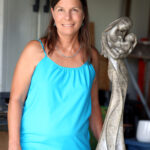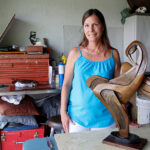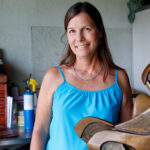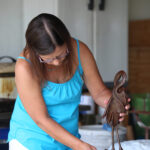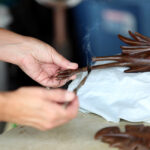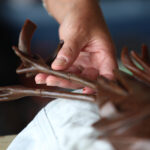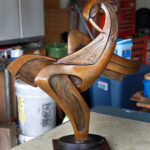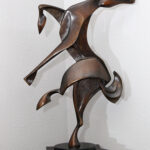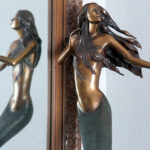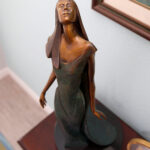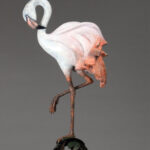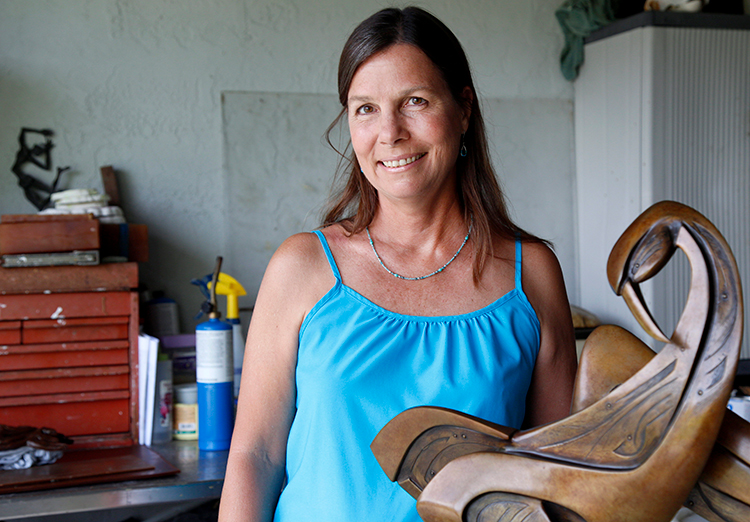
Brenda Truesdale declares emphatically that she’s not afraid of fire. In fact, if she had her way, she would spend most of her time in her garage, blowtorch in hand and up to her elbows in caustic chemicals.
“It’s just me and my work,” she says.
Truesdale is becoming increasingly well known as an accomplished sculptor, whose graceful, linear sculptures are filled with movement, capturing moments of beauty. Such is the case with her “Mother and Child II,” “Anhinga,” “Moondance” and “Fur Elise.”
Truesdale’s pieces are frequently shown at galleries and exhibitions, including throughout the Vero Beach area. Most recently, she received one of the top awards – the Ron Miller Excellence in Art Award – at the Vero Beach Art Club’s 2021 Under the Oaks Fine Arts and Crafts Show.
She has shown twice at the A.E. Backus Museum in Fort Pierce; she had a solo show in 2008 and won the Director’s Choice Award in the 2020 Best of the Best Show. She was also the featured artist in the W.O.M.A.N. Art Show at the Orlando Museum of Art.
Truesdale, who turns 60 this month, says she has always filled her life with art. She began drawing as a little girl growing up in Florida.
“It was something that was always there,” she says. “I used to paint. I’d see something I liked, and I’d just copy it when I was younger. Copy it, paint it.
“I used to like to spend my time in my room, making things (like) candles. My mom hated that. It’s so funny, because it was way back when I was working with wax; doing that in my room which had a carpet … oops, I spilled!”
She enrolled in all the art classes offered by Melbourne High School, and initially also got involved singing with the chorus. At one point, her art teacher said she had to make a choice – art or music. The decision was an easy one.
After high school, she studied under artist Nancy Baur Dillen, who ran the busy and acclaimed art department for the Melbourne campus of what was then Brevard Community College (today’s Eastern Florida State College).
But then, the Ringling College of Art & Design in Sarasota caught her attention. There, she encountered the two loves of her live – sculpture and her husband, Joe Truesdale – while also earning her BFA degree.
“I remember in figure drawing class, she was very good,” Joe recalls. “She had good work. And her work ethic, mainly, she was always putting the time in for sure.”
The two had a lot in common and were in many of the same classes at Ringling. In fact, most of their time together, even on dates, was spent in artsy pursuits.
One of their favorite spots was the “The Big Dig” – a pop-up gallery in a loft where a group of friends lived. The young artists would gather and put on art shows with live music, sending out invitations all around town.
“When you are an artist, you think about it all the time,” says Joe, who builds sets for Riverside Theatre, including the helicopter for the production of “Miss Saigon.”
“She always has a piece going, or modifying, or bringing back something she started before and put to the side,” he adds.
During the roughly 13 years that Brenda worked at the Bronzart Foundry in Sarasota, Joe worked at the Asolo Repertory Theatre and with the Feld Entertainment production company. However, when Joe was offered a job working at an architectural stone business in Michigan, the couple moved north.
“I did a lot of freelance work there,” she says. “I had a little extra studio next to the garage. But it was freezing.”
The couple raised their two children, Rachel and Grant, there, but when Brenda’s mother became ill, the family moved back to Melbourne Beach to help out. She took a job in a bank for a little while, until a friend suggested she teach, and she investigated the possibility.
“That was not on my radar,” she says. “I am so far from being in front of people. I don’t know if I’d say ‘shy’; I let people know what I think. I’m not one to say things out loud right away.”
Still, the idea of teaching appealed to her, so she took education classes designed for degreed professionals to get teaching certifications. For 11 years now, she has taught in the Exceptional Student Education Transition program (continuing education for students who have completed their academic education) at Sebastian River High School.
“I use art a lot with what I do there,” she says. “I bring it in to the students, to get them engaged. The art lessons teach self-advocacy. The students learn that they have a voice to make their own choices. When their work is completed, they can be proud, because it’s theirs.”
Teaching aside, her real passion is creating art, and she looks forward to the time when she can retire and go back to working on her art full time.
Of course, Truesdale is well aware that working on her projects can be bit startling. She recalls a time in 2009, shortly after she and Joe had moved into their home in Melbourne Beach. She was in her garage, door raised, using a roaster to melt wax, while at the same time wielding a blowtorch connected to a propane cylinder.
The process, naturally, creates smoke. A neighbor spotted her and approached.
“He said ‘What are you doing over there?’” Truesdale recalls. “I’m just out there with my shorts and scruffy shirt, barefoot.”
She explained to him that she was working on some art and, looking back, adds, “I should have invited him over.”
The subject of her focus at the time was “Flamenco Dance 1,” a 19-inch bronze sculpture of a white and pink flamenco, poised exquisitely on one leg, its long neck curled into a graceful, preening curve.
Truesdale says she spent about a year working on that piece and explained a little about her process.
“It’s a very laborious field,” she says. “That’s why it’s so expensive. When you get into larger pieces, you can only cast in certain sizes, then piece it back together (by) welding the metal.”
Unlike some other bronze sculptors who begin their projects with clay, Truesdale first creates a wax sculpture, at which she’s more skilled. That wax piece is then made into a rubber mold into which more wax is poured, resulting in a hollow wax sculpture called a “pattern,” about a quarter inch in thickness.
“Compare that to a chocolate bunny,” she explains. “All these bronzes, they are heavy, but they are not solid.”
This hollow wax pattern is then taken to the foundry, where it is cast in bronze. The last step is the patina, for which the sculptor uses a blowtorch to coax colors out of such chemicals as titanium, silver nitrate, ferric nitrate and potassium sulfide. “It’s a design, a movement, a feeling. When I start with something it never ends up with how I thought it would be. It’s a series of decisions as you go,” she says.
“I did a lion for the University of Michigan sorority,” she says. “I would love to get something large to do again. That’s fun, because I can focus on that.”
To view her art, visit TruesdaleBronze.com.
Photos by Kaila Jones

